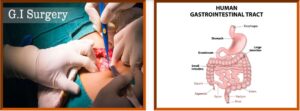Upper gastrointestinal (GI) surgery is surgery performed to treat pathologies of either the upper gastrointestinal tract (small bowel), gall bladder, liver, pancreas or oesophagus.
The upper gastrointestinal (GI) includes the oesophagus (the food pipe), the duodenum (the first part of the small intestine) and stomach.
Why is upper gastrointestinal (GI) surgery done?
The upper gastrointestinal tract is vulnerable to several conditions that may need surgical treatment Upper GI surgery can be done as a:
Oesophagectomy surgery to treat oesophageal tumours, and it involves removing all or part of the oesophagus.
Gastrectomy, a surgery to treat stomach tumours. This involves the full or parial removal of the stomach and nearby lymph nodes.
Minimally invasive laparoscopic (keyhole) surgery. This can be used for resection (removal) of stomach and oesophageal tumours.
A doctor might recommend upper gastrointestinal (GI) surgery if a patient suffers from symptoms including bloating, abdominal pain, heart burn, swallowing difficulties and acid regurgitation. The condition is first evaluated using diagnostic techniques to find the underlying conditions.
Symptoms that may motivate someone to find out if upper gastrointestinal (GI) surgery is right for them may be due to conditions such as:
Inflammation of the stomach
Gastritis or duodenum
A H.pylori infection.
Gastroesophageal reflux disease (GERD)
Peptic ulcers (sores)
Other diseases affecting the motility (ability to move) and the function of the oesophagus.
Symptoms can be caused by stomach tumours or oesophageal tumours. Depending on the location and the stage of the cancer, surgery might be needed for the treatment and management of the cancer.
Preparation for Upper GI surgery
There are several diagnostic procedures to evaluate conditions that may need upper GI surgery as treamment, including:
Upper GI endoscopy , a procedure used to diagnose and treat certain upper GI conditions or problems. It uses special instruments with a laser attachment and camera.
Oesophageal pH monitoring , this measures how often the stomach acid enters the oesophagus. It is most commonly used to diagnose gastroesophageal reflux disease (GERD).
Oesophageal manometry is used to assess the function of the sphincter, the muscle at the lower end of the oesophagus.
These diagnostic techniques can be used to evaluate some upper GI symptoms for example:
swallowing difficulties
abdominal pain
benign (non-cancerous) or malignant (cancerous) tumours.
Upper GI surgery aftercare
Post upper GI surgery patients may need someone to help with heavier jobs such as food shopping gardening or vacuuming for a few weeks.
Some patients feel more confident staying with or having a relative or friend stay with them. Patients are often encouraged to do regular, daily exercise in order to stay active. This reduces the risk of blood clots forming in the legs.



